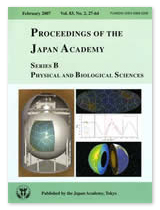About the Cover
Vol. 83 No. 2 (2007)
(Left) View of KamLAND constructed and installed at the Kamioka mine, beneath the mountains of Japanese Alps, about 200 km west of Tokyo. 1000 tons of ultra pure liquid scintillator is housed in a 13-m diameter spherical baloon, and light emissions are detected by 1879 photomultiplier tubes.
(Right-Upper) An example of light hit pattern of an event, detected by the photomultiplier arrays. In this case, the event was caused by a cosmic-ray muon.
(Right-Middle) Neutrino oscillation phenomena, observed at KamLAND. The intensity ratio of observation to expectation as a function of D (=distance)/E (=energy) reveals an oscillational behavior in large L/E values, whereas all the existent data in other experiments cover only very small L/E values and showed the ratio of 1 (no anomaly).
(Right-Lower) Three-dimensional images of the Earth’s interior, using geoneutrinos expected at KamLAND (left half-glove) and seismic data (right half-glove). Geoneutrinos open up a new era for geophysicists and geochemists.
(For details see the review article by A. Suzuki in this issue.)




